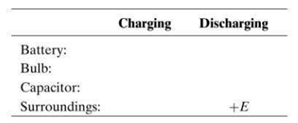You may have noticed that while discharging a capacitor through a light bulb, the light glows just about as brightly, and for just about as long, as it does while charging the same capacitor through the same bulb. Let stand for the energy emitted by the light bulb (as light and heat) in the discharging phase, from just before the bulb is connected to the capacitor until the time when there is essentially no more current. In terms of or , what was the energy change of the battery, capacitor, bulb, and surroundings during the charging phase, and during the discharging phase? One answer is already given in the following table:

It is somewhat surprising that we can get this much information out of one simple observation.




